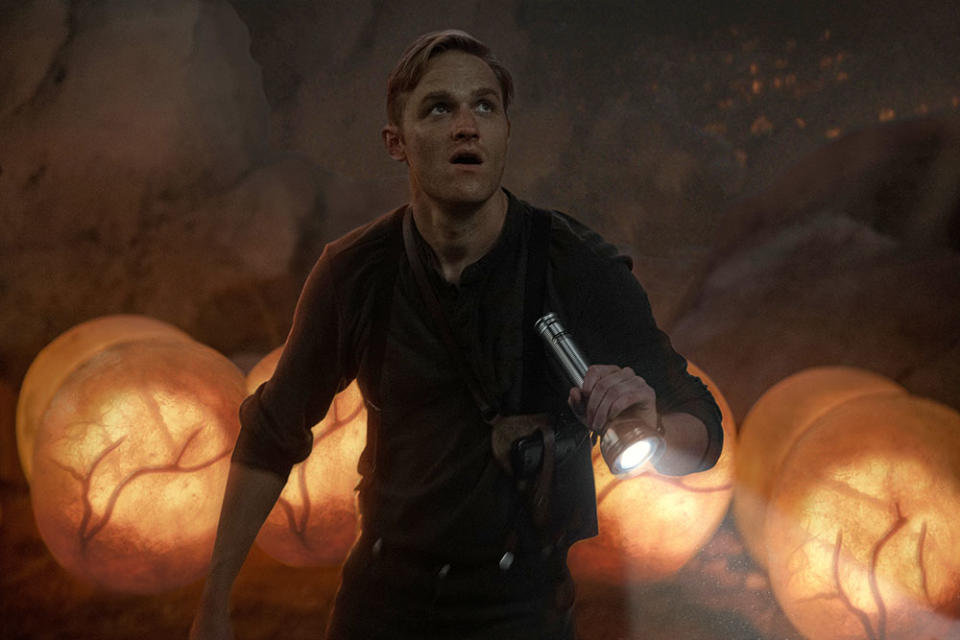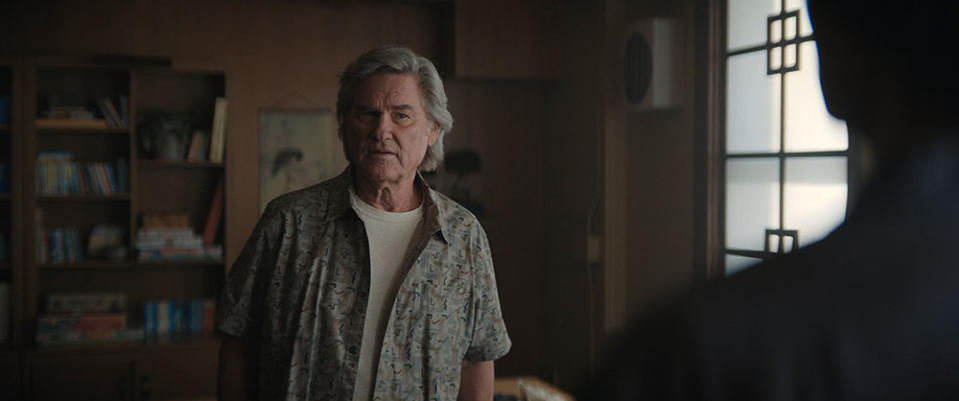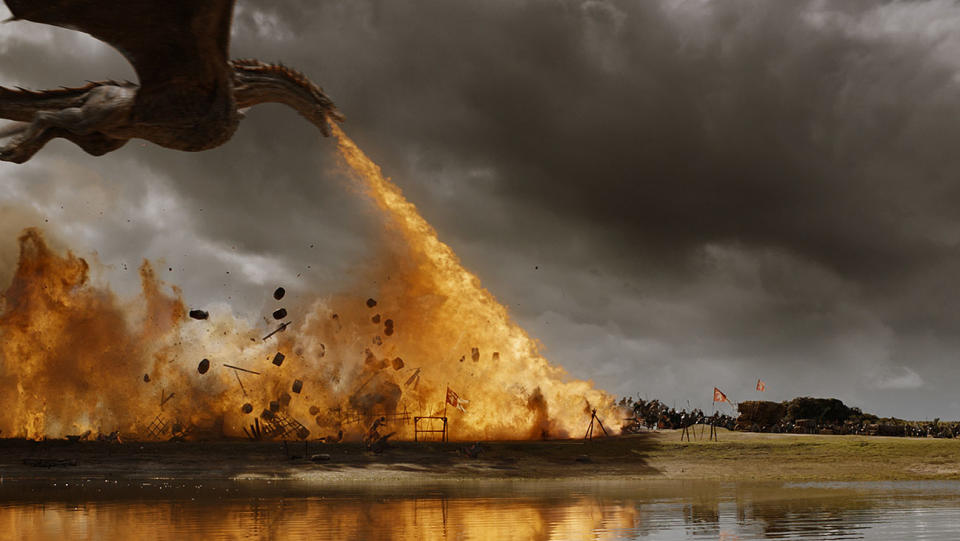‘Monarch: Legacy of Monsters’ Director Matt Shakman on Leading a Second Film Franchise to TV and Those Exhausting ‘Fantastic Four’ Rumors
- Oops!Something went wrong.Please try again later.
- Oops!Something went wrong.Please try again later.

[This story contains mild spoilers for Monarch: Legacy of Monsters’s second episode, “Departure.”]
It hadn’t occurred to Matt Shakman until now that Monarch: Legacy of Monsters and WandaVision both handed him a similar assignment. In each case, the sought-after director had to lead a successful film franchise into television for the first time and explore existing in-universe events from a new point of view. In Shakman’s defense, Marvel Studios’ WandaVision was originally supposed to release after The Falcon and the Winter Soldier, but the latter needed reshoots, thus turning Wanda into Marvel Studios’ first series on Disney+.
More from The Hollywood Reporter
In any event, Shakman’s experience in the Marvel Cinematic Universe served Monarch well, as he knew exactly how to tell intimate character stories alongside the grand scale of the Godzilla and Kong-led MonsterVerse.
“From doing WandaVision, I absolutely learned so much about telling personal stories set against a big large canvas,” Shakman tells The Hollywood Reporter. “One of the things that I loved most about WandaVision was that it was this story of grief that asked, ‘Can you ever truly get over a loss?’ And [Monarch: Legacy of Monsters], created beautifully by Matt Fraction and Chris Black, is similar in its thematics.”
Shakman reinvented his career through his standout episodes on Game of Thrones season seven, both of which featured notable dragon sequences. Coincidentally, at the end of Monarch’s second episode, Shakman was again tasked with introducing a dragon to the terror and reverence of the characters in its path.
“It all gets to this idea of wonder, which is maybe the thing I love the most about movies,” Shakman says. “That’s what I love about Spielberg, Kubrick and Nolan, and this sense of wonder is awe and mystery and fear altogether. Game of Thrones certainly captured those moments a lot, and hopefully, we have some of those moments on Monarch as well.”
Shakman is currently developing Marvel Studios’ long-awaited take on Fantastic Four, and since he was hired in August 2022, casting rumors have intensified with each passing month, as the now-resolved SAG-AFTRA strike delayed any potential casting announcements. However, in the time since Shakman sat down with THR for this story, Pedro Pascal, whose name hadn’t really been a part of the rampant rumor mill, entered into talks for the role of Dr. Reed Richards/Mister Fantastic.
As for all the rabid speculation regarding Marvel’s first family, Shakman is sorry, but not sorry.
“I understand the exhaustion of the Internet rumors, but I also celebrate them, too, because I am a huge fan of the Fantastic Four,” Shakman says. “I certainly spent time wondering who should play them before I had the job of being the person who would cast them, so I understand the interest and I support it. And so there will be an announcement at some point in the future when the strike has concluded.”
Below, during a recent conversation with THR, Shakman also discusses the unique position of directing Kurt and Wyatt Russell’s shared role of Lee Shaw.
So Monarch: Legacy of Monsters and WandaVision were similar undertakings. You had to lead two movie franchises into television, although WandaVision wasn’t intended to be Marvel Studios’ first series. And in both cases, you occasionally had to show a new perspective on existing events. So did your experience on WandaVision serve you well on this?
That’s a very interesting perspective. I had not thought about it that way before. When you started the question, I chuckled because the two shows, to me, are so different. One is a show about sitcoms and grief and all of that. But I love Godzilla in the same way that I have loved Marvel Comics since I was a kid. I grew up watching Godzilla Toho movies with my dad on the couch in Ventura, California. But, from doing WandaVision, I absolutely learned so much about telling personal stories set against a big large canvas. One of the things that I loved most about WandaVision was that it was this story of grief that asked, “Can you ever truly get over a loss?” And this show, created beautifully by Matt Fraction and Chris Black, is similar in its thematics.
It’s about multi-generational family drama, trauma, secrets and mystery, and we follow all of these different emotional tendrils and see how they start to overlap and affect each other. And it’s such an interesting way to tell a story for the MonsterVerse, which I love. I love seeing Godzilla and King Kong battle in the sky; it’s fantastic. But this show is very much about what it’s like to be on the ground and looking up at that experience. How do those moments of trauma affect and change your life? When Marvel Studios was coming to television for the first time, even though WandaVision wasn’t supposed to be the first show, it was great that it was because it was this love letter to TV, and it was about what TV does best. It came out in the middle of the worst part of the pandemic when we were all at home, huddling around our television for warmth and comfort in the same way that Wanda used television.
So, how do you bring the MonsterVerse to television is a similar question, and I think [Fraction and Black] cracked it in their own way, which is to say, “How do you tell a story that’s human-centric and about the people on the ground, and how their lives are shaped and shifted by their experiences with these large, awesome magical creatures?” And it works for television, because that’s what television is. You want to fall in love with characters, you want to root for them, you want to be invested in their journeys, so you come back week to week. And then you get to also see the spectacle and all of the wonderful things of the MonsterVerse, but you’re going to be pulled through not by Godzilla’s journey, but by the journey of the human characters down below.

How much existing MonsterVerse footage did you work with, if any?
In terms of the big sequences, like the Golden Gate Bridge from [Godzilla (2014)], that’s all original footage that we shot. The Skull Island sequence with John Goodman is all original footage, but there is a little bit of footage at the head of the first episode that was taken from Jordan Vogt-Roberts’ [Kong: Skull Island]. It’s when we see from Bill Randa’s [Goodman] camera point of view, and some of it is reprocessed to look like it’s footage from Randa’s 16 mm camera. But the rest of it, all the narrative material for episode one and following was created for this show.
With the film side of MonsterVerse still active, were there any limitations placed on you? Or did you have freedom for the most part?
We did have freedom, but we also worked and consulted with the film division. They have a wonderful mythology department there, and we were dancing in this [existing] timeline and popping in and out. We were literally creating another scene during Godzilla (2014) and another moment that you didn’t see during Kong: Skull Island (2017). So we needed to make sure that we were consistent with the mythology and that we were honoring the MonsterVerse and building on it, and that’s part of the joy of the show. It’s about legacy and history, and it’s about how Monarch started, changed and grew. So, in that way, the limitations were actually a part of our creativity. We wanted to make sure we were fitting into that puzzle and what comes after. And how this show affects future narrative, both in television and film, is to be decided and is to come, but it’s great to be a part of a shared universe.

The casting of Kurt and Wyatt Russell as Lee Shaw, I have to imagine that Wyatt would’ve said no to this role early in his career just because he probably wanted to establish himself away from his family, something he’s clearly done now. He’s a great actor. So, for their dual casting, do you credit the timing of this opportunity more than anything else?
Timing certainly has a lot to do with it. Timing has a lot to do with everything. We were so lucky that they did want to do this, but you’re right. Wyatt is a phenomenal and incredibly versatile actor, and he really has established himself in so many different worlds. What’s great about him is that he’s such a different actor than his dad and his mom [Goldie Hawn]. He’s got his own great style, and the idea that he and his father would create Lee Shaw together by taking a little bit of Snake Plissken and a little bit of what Wyatt does was super fun for them. It was also super fun for me to watch both as a filmmaker and, frankly, just as a bystander. Kurt would sit at the monitor and watch Wyatt do scenes and be like, “I can borrow that. I can take that. I see what he’s doing.” We’d also have costume discussions, and even if Kurt wasn’t wearing it, we’d all want to make sure that it was something they both wanted to wear. And so it was fun to create this character that would have some continuity across a big span of time. [Wyatt’s Lee Shaw] would grow and change and eventually become Kurt Russell’s [Lee Shaw], but he was the same guy at the beginning in certain ways. So, getting them was a luck of timing. They’d been offered a lot of father-son stuff over the years, for sure, and I think they might’ve been open to the right version of that, but this was just such a unique thing and they were excited for the challenge.

Both of your episodes also have some overlap with your time on Game of Thrones, especially the end of episode two. Is it a complete coincidence that you’re working with a dragon again?
Yeah. I learned a lot from working there about integrating real foreground human action and drama with big scale visual effects. And certainly working on “The Spoils of War” episode of Game of Thrones, I really wanted my point of view on that fight to center on the human experience of the Lannister army down below, watching war change forever. They had been up in the sky with Daenerys in moments of triumph as she burned her enemies, but now, this was two beloved characters fighting each other for the first time on that show. And it was that sense of, “Okay, I want to prioritize what it’s like to be a soldier down below with a spear and a shield, seeing an F-16 come into battle for the first time.” And that was incredibly exciting as a filmmaker.
And yes, that was definitely a big part of the approach to this show. I was like, “Okay, now we’re doing the same thing. This is Cate [Anna Sawai] on the ground seeing Godzilla on the bridge, and this is experiencing things from the human point of view.” And episode two, similarly, is their discovery of something incredible. One person might have imagined it, but the others have never imagined what is out there. And that moment changes their life forever. It all gets to this idea of wonder, which is maybe the thing I love the most about movies. That’s what I love about Spielberg, Kubrick and Nolan, and this sense of wonder is awe and mystery and fear altogether. Game of Thrones certainly captured those moments a lot, and hopefully, we have some of those moments on Monarch as well. That’s exciting for me.

I’m not sure if you were involved in the VFX reviews on Thrones, but were you able to add some insight from your previous experiences to Monarch?
Yeah, I was very involved in VFX on Thrones, and I learned a lot during that process. That was an incredible place to work, from the scope and the scale to the amazing filmmakers. Everybody who worked on that show was just the best at what they did. And then working at Marvel on WandaVision and being heavily involved in the visual effects and building that world out, everything has helped put different tools into my toolkit. As I approach things now, I know more than I knew before, and I also realize how little I know about VFX. As you said, things are about timing, and we are always in a new time for VFX. We’re always learning new things and we’re always pushing boundaries, hopefully. The objective doesn’t change, which is you want to fool the eye. You want to make people believe this is real, and while that’s hard to do, it’s the goal.
Alright, Matt, if I never hear another Fantastic Four casting rumor, it’ll be too soon.
(Laughs.)
Are you prepared to end the Internet hysteria as soon as the strike ends? [Writer’s Note: The strike ended shortly after this conversation.]
I understand the exhaustion of the Internet rumors, but I also celebrate them, too, because I am a huge fan of the Fantastic Four. I certainly spent time wondering who should play them before I had the job of being the person who would cast them, so I understand the interest and I support it. We are in the middle of a SAG strike that I hope, knock on wood, ends soon. And so there will be an announcement at some point in the future when the strike has concluded. I would love to share that information, but that’s the best I can do today.
We’ve talked before about how you used to kick-flip up and down Clark Griswold’s driveway as a kid and how you had a full-circle moment when you returned to shoot WandaVision at Warner Bros. Ranch. Well, I thought of you recently because I saw that they tore the entire place down to build soundstages and/or offices. Was that a tough pill to swallow?
Yeah, and you know what? I knew they were going to do it when we were filming WandaVision there. They told us that the plans were already afoot to destroy Blondie Street. But, yeah, I was there when I was a kiddo. I would skateboard down Blondie Street, and I also would skateboard down the Old West town that was once there. So I watched that place go from a magical backlot of the original Warner Bros. era to slowly changing and eroding until all that was left was Blondie Street. And so when we were shooting WandaVision there and knowing that this was maybe one of the last things that would be shot there, it had a lot of poignancy for me. I’d already felt like I was walking among the ghosts of my own past and the ghosts of sitcom past, but then to realize that we might literally be one of the final chapters there, it was very sad. I wish it were still there. I really do.
You’ve been in development on two massive movies [Star Trek 4, Fantastic Four] these last few years, all while directing TV steadily. I assume you still have your theater commitment on top of all that. How have you juggled all of this?
I retired from my position as the artistic director at the Geffen [Playhouse] and passed the baton to Tarell Alvin McCraney, who is an incredible Oscar-winning MacArthur genius grantee. He is going to do an incredible job there, and I’m so happy for the theater and what’s to come there. And that has made it a little bit easier for me to focus on the next project, Fantastic Four. But, yeah, it is a juggling act. I’m also a dad and a husband, and it’s tough to do all those things at the same time, but I love the things I get to do. I’m so lucky to be able to work on Godzilla. I’m so lucky to be able to work with Marvel superheroes that I’ve loved since I was a kid. And so I am there for school drop-off. I’m there to be with my daughter as much as possible and at bedtime and all of that. And then, if I need to work till three in the morning to be ready for the next day’s work, I do it, because I get to do the things that I love and be with the people that I love.
***
Monarch: Legacy of Monsters is now airing on Apple TV+.
Best of The Hollywood Reporter

